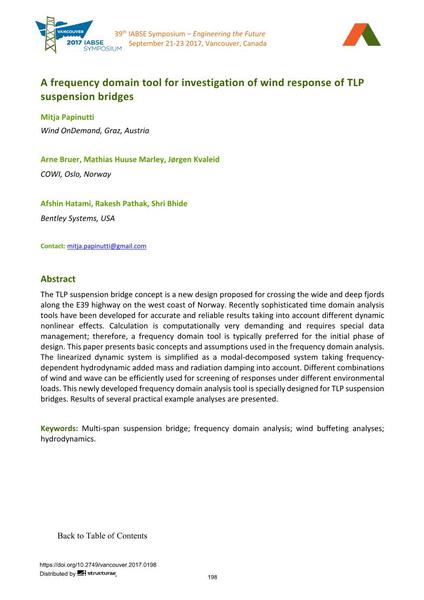A frequency domain tool for investigation of wind response of TLP suspension bridges

|
|
|||||||||||
Détails bibliographiques
| Auteur(s): |
Mitja Papinutti
(Wind OnDemand, Graz, Austria)
Arne Bruer (COWI, Oslo, Norway) Mathias H. Marley (COWI, Oslo, Norway) Jørgen Kvaleid (COWI, Oslo, Norway) Afshin Hatami (Bentley Systems, USA) Rakesh Pathal Shri Bhide (Bentley Systems, USA) |
||||
|---|---|---|---|---|---|
| Médium: | papier de conférence | ||||
| Langue(s): | anglais | ||||
| Conférence: | IABSE Symposium: Engineering the Future, Vancouver, Canada, 21-23 September 2017 | ||||
| Publié dans: | IABSE Symposium Vancouver 2017 | ||||
|
|||||
| Page(s): | 198-205 | ||||
| Nombre total de pages (du PDF): | 8 | ||||
| Année: | 2017 | ||||
| DOI: | 10.2749/vancouver.2017.0198 | ||||
| Abstrait: |
The TLP suspension bridge concept is a new design proposed for crossing the wide and deep fjords along the E39 highway on the west coast of Norway. Recently sophisticated time domain analysis tools have been developed for accurate and reliable results taking into account different dynamic nonlinear effects. Calculation is computationally very demanding and requires special data management; therefore, a frequency domain tool is typically preferred for the initial phase of design. This paper presents basic concepts and assumptions used in the frequency domain analysis. The linearized dynamic system is simplified as a modal-decomposed system taking frequency- dependent hydrodynamic added mass and radiation damping into account. Different combinations of wind and wave can be efficiently used for screening of responses under different environmental loads. This newly developed frequency domain analysis tool is specially designed for TLP suspension bridges. Results of several practical example analyses are presented. |
||||

